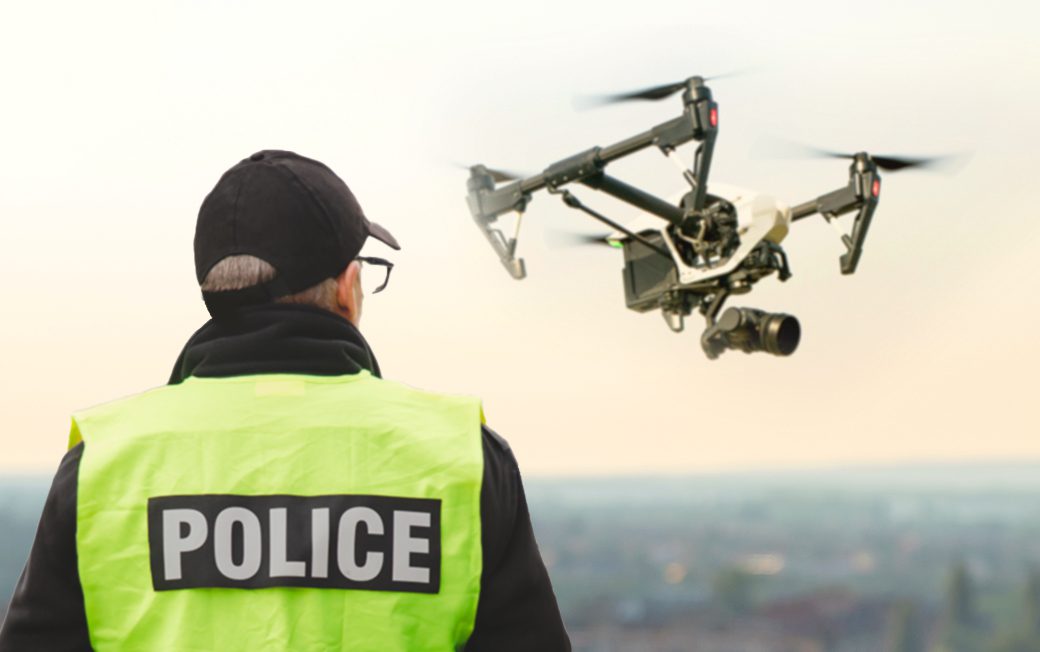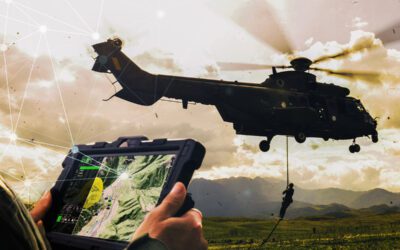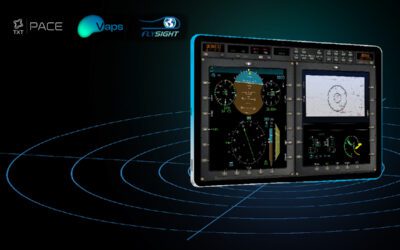The objective of law enforcement agencies isn’t just to ensure that the laws of the land are adhered to by the public and to protect the innocent. Their role is also to prevent crime from happening in the first place rather than simply being a reactive force after the fact. To that end, police surveillance is a major part of their activities.
In this article, we’ll look at the most recent advances in law enforcement surveillance technology, from drones and AI to that stalwart of any surveillance operation, CCTV. We’ll also look at the increasing use of biometrics and cutting-edge technology, such as Augmented Reality, which is already proving to be a real game-changer for accurate and highly detailed surveillance.
We’ll also touch on the ethics of data collection and how law enforcement agencies are walking that fine line between effective preventative operations and protecting the rights of innocent civilians.
The increase in the use of surveillance technology by law enforcement
For decades, police forces worldwide have deployed high-tech surveillance equipment to help them do just that by identifying and tracking suspects’ movements, gathering evidence that can be admissible in court, and preventing areas from becoming ‘no-go’ crime spots.
The development of increasingly complex law enforcement surveillance technology has resulted in modern, highly mobile and adaptable police services customised to tackle the specific problems they encounter in their location. Whether they are operating in a rural or urban landscape, police surveillance technology needs to be adaptable and able to gather information quickly and easily without impeding the rights of innocent civilians.
Law enforcement surveillance – a major business sector
Much of the development of law enforcement surveillance technology doesn’t happen ‘in-house’. Instead, businesses that specifically work in this sector carry out extensive R&D, often working in partnership with the police and law enforcement bodies.
Every year, large conferences and exhibitions showcase the best new ideas. Some, such as Segways with rifle mounts, are clearly destined for the scrap heap. However, other ideas, such as advanced biometrics, drone technology and software applications like Augmented Reality, are far more practical.
In the case of software, immediate integration is possible without the need for new hardware, keeping operating costs down. It also utilises hardware that operators are already familiar with, so training time is cut to a minimum.
Does it work? Chasing down the criminals
The simple answer is yes. Without surveillance, police forces would be effectively ‘working blind’. Surveillance and intelligence gathering form the backbone of any criminal investigation, whether that’s a high-risk target such as a terrorist organisation or a low-level protest organisation. Surveillance is an irreplaceable aspect of law enforcement on every level.
However, there is always a caveat to surveillance and intelligence gathering, and that’s just how far do you go. The reason so many governments have enforced legislative boundaries regarding surveillance is to ensure that the rights of innocent individuals are protected. However, as electronic surveillance has continued to become more and more advanced, that legislation may need to be examined in more detail.
The ethics of data collection have to be weighed against the effectiveness of the investigation itself. The public is already wary of ‘Big Brother’ surveillance techniques as used by some regimes. So, it is imperative that new surveillance technology does nothing to inflame this mistrust but instead uses more finely tuned targeting to hone in on the real perpetrators. In short, the ‘background noise’ of the innocent population needs to be filtered out. And that’s where the latest surveillance technology comes into its own.
CCTV – the bedrock of police surveillance
With limited resources, it is physically impossible for law enforcement agencies to have a police officer on every street corner. What they can have, however, is a camera. Easy to install, reliable, and operated remotely from a central location, CCTV cameras are commonplace in every town, village and street across the globe.
CCTV technology produces better cameras that deliver high-definition images, even at night. Multi-spectrum cameras can quite literally see in the dark, while the use of colour imaging produces far clearer results during the day.
Their reliability and accuracy mean that CCTV cameras will continue to be a significant factor in future police surveillance operations. The increased use of police mobile surveillance cameras also adds to the coverage that CCTV provides through airborne cameras, drones (more on that shortly), and 4K body cams.
In fluid scenarios (such as when a large crowd is expected to gather), mobile surveillance trailers that utilise solar panels to power the cameras are increasingly used in some parts of the world. In colder climates, it may not be as practical. But in the Middle East and some parts of the USA, for example, solar trailers are a viable tool in crowd control surveillance at large events or demonstrations.
These mobile units can also be used in traffic scenarios and integrated with advanced licence-plate recognition software to identify target vehicles or those that are not insured. Rather than being simply ‘revenue generators’, these roadside units ensure that dangerous and unroadworthy vehicles or banned drivers can be taken off the road, protecting other motorists.
Drones – eyes in the sky
Drones are increasingly used by police and law enforcement operators. Drones or ‘Unmanned Aerial Vehicles (UAVs) are an ideal piece of technology for a wide range of applications, including crowd monitoring, aerial reconnaissance, search and rescue and crime scene work. Because of their compact size and manoeuvrability, they can get into positions that a larger airborne unit like a helicopter couldn’t.
New developments in drone technology include units that can be powered up and operated remotely, much like the larger military versions currently deployed in many conflict areas. Image stabilisation software ensures clear, sharp results. Some more sophisticated drones carry additional technology, such as 3D mapping and geospatial software for greater precision or thermal imaging that can assist in search and rescue operations in particular.
The only issue with drones that needs to be addressed to make them more effective is a longer battery life. Currently, small drones can only stay in the air for minutes rather than hours. While it is possible to set up a ‘relay’ of drones for extended periods, battery technology does need to advance to make them more effective as surveillance equipment.
AI – its role in law enforcement surveillance
The biggest technological advance in the past couple of years, not just in law enforcement but generally, has been AI. Artificial Intelligence is permeating every aspect of modern life. While it has its flaws (as any 1.0 version of a tech advance will), it does have enormous potential to work alongside human operators, especially in surveillance scenarios.
Until the bugs have been ironed out of AI, though, there are limitations as to its uses in police surveillance operations. Where it can assist is in the analysis of the remarkable amounts of data now being collected.
Using AI (alongside human operators) to sift through this data reduces the amount of time and money it costs to process information gathered by surveillance units. Machine learning means that AI can adapt and refine its process. Applications include facial recognition (still a contentious issue in many parts of the world), crime mapping to identify high-crime areas, and biometrics such as gait recognition.
AI is also at the cutting edge of ‘crime forecasting’. By using deep learning algorithms, AI can be programmed to analyse data from multiple sources to predict where crimes may occur. While this does sound a little too close to the plot of the film ‘Minority Report’, predictive surveillance has been used by law enforcement operators ever since the first policemen hit the streets. The only difference now is that the volume of data being sifted through to make these predictions is far greater. This, in turn, makes the results more accurate.
The use of 5G in surveillance technology
With many countries switching off their 3G networks and relying purely on 4 and 5G instead, the greater coverage that these stronger signals provide allows advanced surveillance technology to operate more effectively. 5G makes wireless video surveillance more accessible for use in remote locations and allows more devices to connect to a single network. 5G will allow advanced surveillance technology to penetrate new and more diverse markets, as well as drive forward the development of new equipment.
Airborne surveillance – making the best use of an expensive resource
Airborne surveillance plays an ever-increasing role in law enforcement. While low-level operations are being replaced in many cases by police surveillance drones, airborne units are ideal for covering a larger target area or relaying information to ground units in the event of a chase.
Helicopters are expensive to run, so making the best use of this costly resource is essential. They’re also limited when it comes to cabin space, so any advances in surveillance equipment have to be compact, effective, and intuitive.
Fortunately, new technology developed by companies such as FlySight makes this a reality through Augmented Reality.
FlySight produces a range of turnkey solutions for surveillance operators, including geospatial software and augmented reality, to optimise efficiency and make the most of flight time. This software grandfathers straight onto familiar hardware, reducing the time it takes operators to learn their way around the intuitive system.
OPENSIGHT is a multi-platform processing, exploitation and dissemination (PED) system that integrates geospatial layers to enhance visual representation. Using modular plug-ins, simultaneous GIS and 3D graphics rendering, it provides operators with crucial information at a glance.
The AR system can also use machine learning to identify and follow specific target vehicles, effectively filtering out the background noise and allowing the operator to focus on a specific target. It also has a role in monitoring large crowds, surveilling both urban and rural locations, and identifying targets in search and rescue operations.
OPENSIGHT has been developed in accordance with STANAG guidelines and rules and is fully customisable.
It is this next-level R&D that is helping police surveillance technology become more efficient and more effective at reducing crime and preventing it in the first place. AR, in particular, represents the future of modern police surveillance.
Find out more about OPENSIGHT here, or contact us in confidence to discuss your needs.





